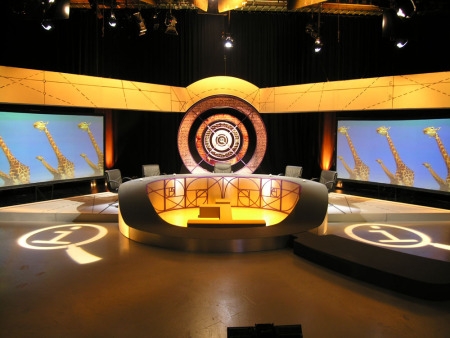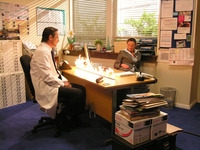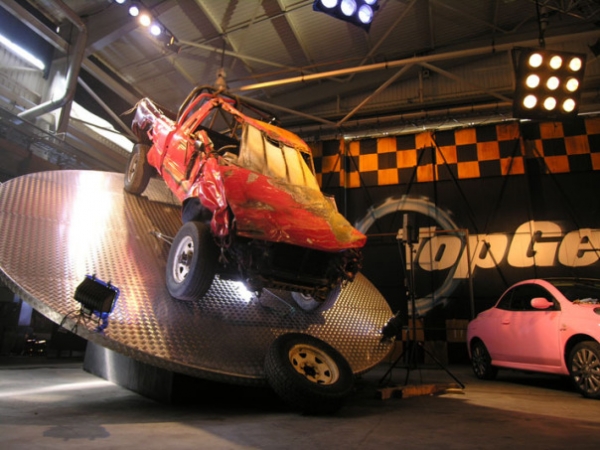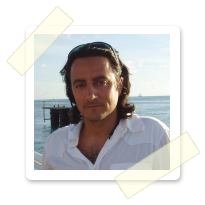Jonathan Paul Green, Production Designer
Brasseye, Ali G, Mock the Week, Green Wing, QI, Episodes and Smack the Pony. Production Designer Jonathan Paul Green is one of the country's leading creative talents. As well as some of the biggest comedy shows of the last 15 years, Jonathan has also designed Top Gear, Children in Need, Top of the Pops and the MOBO awards.
What are you working on at the moment?
I’ve literally just finished working on Season 2 of Episodes starring Matt LeBlanc, which we shot in London and LA. Right now I’m working on a few small pilots, getting Top Gear up and running, and have a couple of new possible sitcoms coming soon.
What got you started in the industry?
I left Art School having studied sculpture, and started working in the Spitting Image workshop making puppets. I also did some prop and model making on Indiana Jones and that basically set me on my course.
One of your early design jobs was Brasseye, what did you make of it when you read the scripts and what influenced the look you gave it?
Chris Morris had a big hand in the overall look, which was fantastic, because he’s a genius. The scripts were really unusual and surreal, which to be honest, is an absolute dream for being creative, and suited me perfectly having come from a Fine Art background.
You designed The Ali G Show, what can you tell us about the design process and working with someone like Sasha Baron Cohen?
Working with Sasha was a real treat. I felt very privileged. He was at the early stages of his career, but I knew he was destined for great things even then. He has an amazing comic mind, and as with Brass Eye, I had a very free reign to be as creative as possible, with almost nothing being taboo (which is very rare!)
I started by buying loads of American import hip- hop magazines and flicking through for inspiration. The street graffiti vibe was an obvious choice, so I tried to use it sparingly, but there’s so much visual interest in that genre, and nothing could be too bling for Ali-G.
Somehow you seem to get more inspired when you’re working with utterly brilliant characters.
I shared a lot in common with Sasha, and we all had a great deal of fun making Ali-G. The hardest part was not laughing during takes.
 You are asked to design for lots of live shows like Children in Need, the MOBO’s Top of the Pops & Daybreak. What technical and practical considerations go into those creations?
You are asked to design for lots of live shows like Children in Need, the MOBO’s Top of the Pops & Daybreak. What technical and practical considerations go into those creations?
The only difference with a live show, is that there’s no opportunity to change or fix anything once filming starts. It has to be perfect from the get-go, which means making sure the set looks good from all camera angles. There’s a great buzz of excitement around a live show, it’s very different, which can also mean ‘stressful’.
Top Gear has become one of the BBC’s most successful series in the world. How did it go from cuddly magazine show to racing hangar?
I joined the show about 5 years ago, when they moved from a smaller, set-less warehouse into the bigger hangar they now occupy. I worked with the Director Brian Klein and Exec Producer Andy Willman to come up with a concept that encompassed the Top Gear ethos, whilst still allowing plenty of space for the huge audience. I wanted to design something that was a bit like a museum for Top Gear history that had the grit and grunge of a high-octane car show.
So I designed a series of vehicles on ramps that would be visible above the crowds, painted the huge hangar door and designed an area inspired by Airfix models. The Cool Wall already existed, but it was just a simple board, so I re-designed it with different branding for each section.
I think the show has just evolved and grown into this huge being, which is tremendously popular with women, which is a great testament to Andy Willman’s vision and expertise.
 You have designed several long running format shows like QI and Mock the Week. Were you drawn to comedy or was comedy drawn too you? Also, do you wish that you could give those sets an annual make-over?
You have designed several long running format shows like QI and Mock the Week. Were you drawn to comedy or was comedy drawn too you? Also, do you wish that you could give those sets an annual make-over?
I think fundamentally, I was drawn to Comedy. It’s such a fun and exciting genre, and all the people that work in it tend to have a great sense of humour. It’s definitely where I’m happiest.
As far as annual makeovers, once you’ve worked hard to establish a look, it becomes very difficult to change it. The audience become familiar with it and generally gets upset if you change anything.
Once a show has it’s look, it becomes part of the brand, and so any changes are not normally well received. I do sometimes ask to tweak things, and sometimes I’m asked to add things, but normally its because there wasn’t enough money to do everything first time around.
When you are not working, where do you look for inspiration?
It’s actually quite rare that I’m not working! Actually right now is about the quietest I’ve been for ages, and I’m still working.
That’s not through greed or excessive ambition, I just love to be busy with interesting projects. It’s also more likely that I’m simply terrible at saying no!
Inspiration is the toughest thing to come by, particularly when you need to be inspired to a tight deadline. Thankfully, with the Internet, it’s easier and easier to find things and stumble across new inspiration. I still tend to flick through magazines, but ultimately, it’s a good old pencil and paper that gets my brain into creative mode. I’m a bit ‘old school’ in that respect, but my artistic outlet has always been a sketch book.
Your work flips between studio based projects and location work, do you have a preference?
No, not really. I like to do both. I’ve been very fortunate that I’ve never been pigeon-holed as one type of Designer. I would hate to work in just one discipline. I think I’m a bit of a free spirit. I like to be challenged with new and exciting things all the time. Every single job is different, and I love doing things I’ve never done before.
Having said that, studios are always preferable during the winter.
 Which set or project are you proudest of and why?
Which set or project are you proudest of and why?
It’s almost impossible to single one out, so I’ll be cheeky and list a few.
I think I’d say Green Wing (right) and Episodes for it’s overall scale and look, and the fact that I was able to successfully make the sets look as real as the locations.
I’d also say Q.i for it’s lovely design (without wanting to be too over self-congratulatory). It’s simple but works so well in the context of the show and is a joy to work on.
And finally the Mobo Awards, because everybody there told me it was the best it had ever looked, and it was an incredible event.
What’s been your best day at work?
That’s a good question.
I’ve been very lucky. I’ve worked on some great shows with some incredible people.
I’ve had a number of best days at work, but recently, having David Crane (who wrote Friends) and Jeffrey Klarik walk on to my set and tell me it was amazing, has to be one of them.
If you could give a producer one piece of advice about design or the art department, what would say?
Don’t ask Designers to pitch set designs. Meet with them, interview them, discuss the project, and then decide who’s best suited to your team. Or at least after that process, just ask 2 people to offer up set ideas, and pay them for their time. Working collaboratively gives everybody a far better end result.
Asking a designer to pitch one look is as useful as asking a musician to play one note.
 What do you look for when getting your team together for a project?
What do you look for when getting your team together for a project?
It’s easy to go for familiarity and to use people you know and trust.
I’m after hard working people with a passion for what they do and a commitment to the job.
I also look for people that will work well together as a team, and people that are proactive. People that will spot a potential problem without me having to point it out to them.
I’m a very fair person, but if people take advantage, I tend to lose faith in them.
It’s a tough demanding job, so being personable and friendly is vital.
If you could change one thing about the UK film and TV industry, what would it be?
Apart from the pitching process in TV Entertainment that I mentioned earlier, I’d really like to see some sort of trainee scheme to help people into the business.
I’d also love to see some tax incentives from the Government to encourage more films to be made in the UK, and finally, I’d like to see TV Broadcasters offer up more money for a second series if a show is successful enough to be brought back, like they do in America, rather than offer Production Companies less money than the first time.
I also wish that people were rewarded more for the efforts across the board, rather than having to deal with crew rates that have stayed the same for the last 10 years.
I know you said “one thing” but how many wishes am I allowed?
What do you do to you relax when you are not working?
I love going away on holiday with my family, and spending ‘normal’ time with them.
I also love walking and hiking. I climbed Kilimanjaro last year, and it’s totally given me the bug.
Is there anyone you would you most like to work with (that you haven’t already)?
I’d love to work with Ricky Gervais, the producers of Modern Family or Terry Gilliam. If not them, I’d be happy with anybody that’s highly creative with a great vision, and a passion for the craft of making shows.
You can find out more about Jonathan and his work on his website. Check his profile page on thecallsheet.co.uk and follow him on twitter
